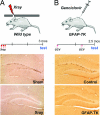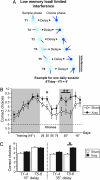Paradoxical influence of hippocampal neurogenesis on working memory
- PMID: 17360577
- PMCID: PMC1810330
- DOI: 10.1073/pnas.0611718104
Paradoxical influence of hippocampal neurogenesis on working memory
Abstract
To explore the function of adult hippocampal neurogenesis, we ablated cell proliferation by using two independent and complementary methods: (i) a focal hippocampal irradiation and (ii) an inducible and reversible genetic elimination of neural progenitor cells. Previous studies using these methods found a weakening of contextual fear conditioning but no change in spatial reference memory, suggesting a supportive role for neurogenesis in some, but not all, hippocampal-dependent memory tasks. In the present study, we examined hippocampal-dependent and -independent working memory using different radial maze tasks. Surprisingly, ablating neurogenesis caused an improvement of hippocampal-dependent working memory when repetitive information was presented in a single day. These findings suggest that adult-born cells in the dentate gyrus have different, and in some cases, opposite roles in distinct types of memory.
Conflict of interest statement
Conflict of interest statement: E.R.K. declares a conflict of interest (such as defined by PNAS policy). E.R.K. is one of four founders of Memory Pharmaceuticals and is Chairman of its Scientific Advisory Board. Memory Pharmaceuticals is concerned with developing drugs for age-related memory loss. Some of these drugs are also potentially useful in depression and schizophrenia. E.R.K.'s own laboratory is not involved in developing these drugs. E.R.K. is also a consultant for BrainCells, Inc., which works on neurogenesis, an area in which he is not directly involved.
Figures




Similar articles
-
Ablation of hippocampal neurogenesis impairs contextual fear conditioning and synaptic plasticity in the dentate gyrus.Proc Natl Acad Sci U S A. 2006 Nov 14;103(46):17501-6. doi: 10.1073/pnas.0607207103. Epub 2006 Nov 6. Proc Natl Acad Sci U S A. 2006. PMID: 17088541 Free PMC article.
-
Inhibition of adult hippocampal neurogenesis disrupts contextual learning but spares spatial working memory, long-term conditional rule retention and spatial reversal.Neuroscience. 2009 Mar 3;159(1):59-68. doi: 10.1016/j.neuroscience.2008.11.054. Epub 2008 Dec 16. Neuroscience. 2009. PMID: 19138728
-
Time-dependent enhancement of hippocampus-dependent memory after treatment with memantine: Implications for enhanced hippocampal adult neurogenesis.Hippocampus. 2014 Jul;24(7):784-93. doi: 10.1002/hipo.22270. Epub 2014 Mar 19. Hippocampus. 2014. PMID: 24599753
-
Morris Water Maze and Contextual Fear Conditioning Tasks to Evaluate Cognitive Functions Associated With Adult Hippocampal Neurogenesis.Front Neurosci. 2022 Jan 3;15:782947. doi: 10.3389/fnins.2021.782947. eCollection 2021. Front Neurosci. 2022. PMID: 35046769 Free PMC article. Review.
-
Interaction between Neurogenesis and Hippocampal Memory System: New Vistas.Cold Spring Harb Perspect Biol. 2015 Jun 1;7(6):a018952. doi: 10.1101/cshperspect.a018952. Cold Spring Harb Perspect Biol. 2015. PMID: 26032718 Free PMC article. Review.
Cited by
-
Impaired terminal differentiation of hippocampal granule neurons and defective contextual memory in PC3/Tis21 knockout mice.PLoS One. 2009 Dec 17;4(12):e8339. doi: 10.1371/journal.pone.0008339. PLoS One. 2009. PMID: 20020054 Free PMC article.
-
Impaired spatial and contextual memory formation in galectin-1 deficient mice.Mol Brain. 2011 Sep 1;4:33. doi: 10.1186/1756-6606-4-33. Mol Brain. 2011. PMID: 21884595 Free PMC article.
-
Traumatic brain injury-induced hippocampal neurogenesis requires activation of early nestin-expressing progenitors.J Neurosci. 2008 Nov 26;28(48):12901-12. doi: 10.1523/JNEUROSCI.4629-08.2008. J Neurosci. 2008. PMID: 19036984 Free PMC article.
-
Impaired cognition, sensorimotor gating, and hippocampal long-term depression in mice lacking the prostaglandin E2 EP2 receptor.Exp Neurol. 2009 May;217(1):63-73. doi: 10.1016/j.expneurol.2009.01.016. Epub 2009 Feb 3. Exp Neurol. 2009. PMID: 19416671 Free PMC article.
-
Regulation and function of adult neurogenesis: from genes to cognition.Physiol Rev. 2014 Oct;94(4):991-1026. doi: 10.1152/physrev.00004.2014. Physiol Rev. 2014. PMID: 25287858 Free PMC article. Review.
References
MeSH terms
LinkOut - more resources
Full Text Sources
Medical

